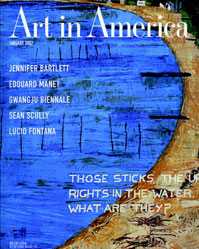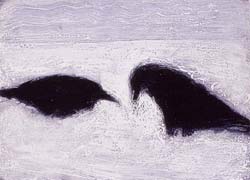Reviews
 Art in America
Art in America
February, 2007
Colin Cochran at Joyce Goldstein
by Edward M. Gomez
Click cover for review.
 Art & Antiques
Art & Antiques
October, 2003
Reimagining the LANDSCAPE
by Edward M. Gomez
Contemporary American painters bring fresh ideas and techniques to a classic art form.
Click cover for review.
Reviews

Crows in the Snow, Oil, Glaze, Gouache and Charcoal on Gessoed Board, 19″ x 23″, 2002, Private Collection
James Kalm, NY Arts Magazine
from his review of Colin Cochran’s
March 2002 exhibition
at the Andre Zarre Gallery in Chelsea, NYC
“A torn piece of brown wrapping paper, or a time worn panel of corrugated cardboard, each seems to have had an interesting if tough history before they started life anew as grounds for the paintings of Colin Cochran. Beginning with such humble materials, Cochran builds fragile almost ghostly images using an unorthodox mixture of techniques. Breaking all the rules regarding the layering of oil and water based media, the artist is able to develop beautiful and unexpected results that tickle the eye and seem to have been created in a partnership with nature that doesn’t allow for ether participant to dominate. It is appropriate that the paintings with their scumbled forms, profuse glazing and resist washes have such an organic process, because they depict earthy images that are at once simple and profound, images such as fishes, trees, birds, eggs, cacti, even comets. “El Capitan” is a massed deep blue form that cuts from lower left to upper right. The composition is keyed to cool grays and blues. The intense reworking and simplification of the subject seem to justify the use of ragged cardboard as a receptive surface for this kind of pictorial massage. Though the palette used is generally limited and subtle in its contrasts, Cochran gets engaging effects. In “Crows in Snow,” two black forms are surrounded in a gray field of washes. With a slight shift in tone, and a change in brush stroke direction, a horizon is developed. The feeling of late winter is palpable. Cochran’s resume states that his three summers studying with Gandy Brodie were a seminal point in his development as an artist. During a brief chat he also mentioned his attachment to Ryder, whose tenuous surfaces, bizarre techniques, and incessant overworking of paintings relate to Cochran’s own practices. An interesting study could be made of this kind of painting. That is, a type of painting in which the materials themselves and the physical nature and feel of paint carry embodied meanings that transcend graphic syntax. The AbEx painters dabbled in this realm. I believe there is a line of figurative painters beginning with Rembrandt through Von Marees, Ryder, and Brodie who developed this sensibility. Cochran is a contemporary painter who is carrying on this quest.”
Bonnie Finberg, Cover Magazine
from her review of Colin Cochran’s April 1995
exhibition at the Joyce Goldstein Gallery, NYC
“Colin Cochran’s small, but compelling, oil paintings hover on the border between image and abstraction. Concerned with themes of the natural world, they arise organically from a process where the ephemerality of color creates a shadowy iconography of archetypes. While he has been influenced by the Northern Romantic tradition, he works more within the sensibility of ancient cave paintings. Here the act of painting itself becomes a way of rendering a uniquely human interpretation of the physical world. His “Persian Gulf” creates an impenetrable wall of blackened red. Only 8″ x 30″, it is a powerfully conceived document of the destructive forces operating within and against nature. His paintings of animal and plant life underscore their fundamental interdependence with childlike awe. “Tree with Chicken” presents a spectral tree whose dense foliage hangs protectively over the isolated creature standing beneath its shade. In their vulnerability and humor, these creatures experience existence not much differently than artist or viewer. They remind us of our basic innocence, despite ourselves.”

Mountain Range (On Tile), Mixed Media on Ceramic Tile, 4 3/4″ x 4 1/4″, 2004, Collection of the Artist
John Mendelsohn, Art Critic
“Colin Cochran’s paintings are small energetic mysteries. Deciphering both the import of individual images and their imaginal origin is the task that the artist puts before the viewer. Fortunately, we do not lack for clues to begin to decode Cochran’s gathering of signs. Each painting is devoted to a single image, located centrally, often on a sheet of paper with irregular or torn edges. The animal or architecture appearing there is defined by cursory brushstrokes, floating on a field of flowing or roughly scumbled pigment. The play of glazes and gouache gives the paintings a surprising luminosity. At times the images have the simplicity of ancient pictographs, as in the case of the single and twinned fish. A kind of gestural abstraction defines the approach best exemplified by “Shooting Star,” where the image is all fevered energy. In “Sitting Crow,” “Giant Sequoia,” and the aqueduct paintings, an iconic expressionism prevails. Individually, the images are both highly personal and evoke the iconography of ancient cultures, particularly those of classical antiquity and the early Christians. There are the fish, recalling the traditional symbolism of Christ and the souls he redeems. And there is the star, with its cosmic implications. The arched aqueducts transport us to the heart of the Roman Empire. In their fragmentary formats, the single images take on the quality of ruins or shards of frescos. Many of the images, like the crow, the crab, and the tree, carry with them a range of sacred and mythological associations from both Western and non-Western cultures. Collectively, the images have, in equal measure, a vigor and a pathos that point us beyond specific symbolism to a more primal level of experience. The mystery in Cochran’s work is ultimately an appeal to the sense of the extraordinary that has, from pre-history’s earliest examples of artistic expression, always informed the depiction of signs and wonders.”
